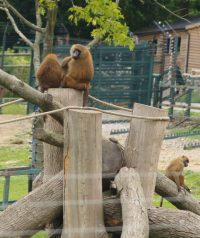Each lesson culminates in an assignment which is submitted to the school, marked by the school's tutors and returned to you with any relevant suggestions, comments, and if necessary, extra reading.
AIMS

- Describe the nature and scope of zoos as a source of education and conservation.
- Develop appropriate procedures for managing occupational health and safety in a zoo, with a view to minimising risk to staff, animals and visitors.
- Describe the nutritional requirements and feeding preferences of animals within zoos.
- Determine health management measures for different captive zoo animals.
- Describe breeding management in zoos.
- Determine appropriate ways to manage a range of different wild animals in zoos.
- Explain procedures and techniques for human-animal interactions in zoos.
- Identify and describe the qualities of good enclosure design.
- Develop an environmental enrichment program for a captive animal.
Feeding Animals in Zoos
Food storage and presentation should be undertaken in conjunction with strict guidelines. Food-borne illnesses readily occur when food is not stored properly. There are pathogenic hazards such as bacteria, viruses, parasites and fungi that can cause illness in both humans and animals. Five things need to be considered to ensure food is stored safely. These are:
- Temperature
- Pest control
- Package integrity
- Storage integrity
- Time limit (shelf-life)
All food should be kept in appropriate containers to ensure that the nutritional value of the food is retained for as long as needed. Fridges and freezers need to be kept at appropriate temperatures for storing fish, meat and vegetables. Dry food such as grain and pellets need to be kept free of moisture in containers that are appropriately labelled and checked regularly.
Hay for herbivores should also be kept off the ground to avoid mildew and other contaminants. Live vertebrate food should not be given to carnivorous or omnivorous animals. Live insects should be kept for frogs. Animals that are used as food should be euthanised humanely. They should also be frozen and thawed thoroughly before being fed to animals such as reptiles and birds of prey.
Food preparation should be carried out in accordance with relevant federal, state or local regulations (eg. AZA Accredited Standards). Meat must always be processed following relevant health standards.
Presentation Matters
As species vary in their feeding habits, the way in which food is presented is very important. For example, herbivores will generally graze throughout the day requiring permanent pasture or access to fresh greens on a daily basis. Carnivores on the other hand will feed more intermittently and may like to work for their food. As mentioned previously, animals in the wild forage for food, many zoos try to replicate this behaviour as a form of enrichment for larger animals. If food presentation becomes monotonous stereotypical behaviours may arise. This monotony can be broken by replicating natural feeding behaviour of the animal.
It is also important that food is made available to all individuals in an enclosure. This can be ensured by spacing feeding points out within the enclosure to minimise competition, provide separate feeding stations for new individuals that may not be integrated into the group and time feeding to ensure all animals have access to food. It may also be necessary to isolate certain animals (such as snakes) during feeding as there can be accidental injury or ingestion of other animals during this time. Feeding behaviour of species that require intervention should be carefully observed.
As mentioned above, there are ethical issues with feeding live food to carnivorous animals. It can also be quite dangerous for the predator, such as snakes that can injure themselves inside a small enclosure when trying to catch prey. In the wild, when snakes are ready to feed they are in hunting mode, probably laying in wait and camouflaged. In an enclosure setting, the snake is not prepared and the live mouse or rat can startle the snake by running towards it. This can lead to injuries. If the snake does not catch the prey straight away, it can sometimes become the victim, with the mouse or rat biting at the snake that cannot escape.